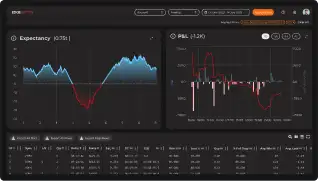
October 30,2024 @10:30 AM
Even for traders who are consistent, disciplined, and well capitalized, trading can be filled with emotional, financial, and even physical ups and downs. No matter the amount of experience a trader has, there will always be periods of doubt. It can often be hard to stick with it after a series of tough losses. During these periods, it can be difficult to recognize whether you are in a temporary rough patch or if it is time to step back, rethink your approach, and make the necessary adjustments to your trading strategy, including re-evaluating your stop outs.
The truth is, even the most successful traders in the world experience downturns. Many of the best trading plans may only have close to a 50% win rate—sometimes even lower. What’s the secret that separates profitable traders from the rest? These traders have been able to turn a 50/50 strategy into a winning one by applying discipline. Traders do this by developing a strong risk management plan and quickly adapting to market conditions, knowing when to implement stop outs. For instance, winning 500 trades out of 1,000 with just a slight advantage can lead to a net positive strategy.
These traders not only excel at managing their trades but also demonstrate discipline in all areas of life, from family commitments to physical fitness and mental health. If you aren’t feeling at your best mentally or physically, it’s more likely that you are not going to trade well and may need to enforce personal stop outs. A trader who lacks focus or is dealing with high stress isn’t likely to achieve the desired outcomes in the market.
With that in mind, it is crucial to ask yourself an important question: What is your stop out?
Defining Your Personal Stop Out
When I refer to a “stop out,” I am not just talking about a stop-loss on a trade, although that is an essential part of managing risk. I’m talking about recognizing when it’s time to take a strategy you’ve invested time, money, and energy into back to the drawing board. At what point do you take a step back, re-evaluate, and rework your entire plan, considering the need for stop outs?
This idea of having a personal stop out came to me early in my career. I had a mentor who asked me a simple but powerful question: “What’s your poison pill?” At the time, I was fixated on a breakout strategy that, in hindsight, was poorly thought out. He likely knew that my strategy was not going to work, but he didn’t tell me it would not work. He simply asked me, “What is your poison pill—your stop out point? At what point is this invalidated?”
As a 22-year-old, I did not have an answer. I was so focused on executing the plan that I didn’t think about the possibility of it failing. I took this question to heart after losing some of my precious live capital. For newer traders, this question is crucial and applies to many areas of life beyond trading, such as recognizing when to implement stop outs.
Stop out on a Trading Plan: When to Re-evaluate
There is a graveyard of traders who once found success in the markets, but failed to recognize when their strategy no longer aligned with current market conditions. Whether it’s a change in policy, shifting market trends, or current events, all strategies can hit a wall. Refusing to adapt to this can be a trader’s downfall.
Part of your trading plan should include a built-in point of re-evaluation. You should ask yourself: “Is my strategy still working, or is it facing difficulty due to evolving market conditions?” If a plan that usually has an edge is no longer serving you, it is likely time to consider pausing, re-evaluating, and even scrapping certain setups.
This should not be seen as a failure, but as an opportunity for growth. “Don’t view this as a failure; see it as an opportunity for growth. The discipline needed for futures trading calls for constant improvement. If one of your strategies were to underperform, it’s not underscoring your ability as a trader, it is simply a sign to reassess and evolve as a trader.
Want to learn more about building a strong trading plan? Read my blog post that discusses funding, risk management and accountability, and the key questions to consider here!
Monetary Stop Outs
While this may seem obvious, you need to have a set monetary stop-out in place for every trade. You can set this as a stop directly on the order book or establish a loss limit ahead of time. Either way, it’s important to know the exact point when a trade becomes invalid.
There are many ways to establish your monetary stop out. Some traders will say it is when the market moves to a point where the trade is unlikely to work. Others will stick to hard dollar or percentage limits relative to their account size.
I’ve found that many of my bad trading days could have been avoided by strictly sticking to my predefined stop-out levels. I have learned the hard way that sticking to your limits is crucial. When you are formulating a trading plan, knowing your exact stop out is critical.
Personal Stop Outs
Let’s shift the focus from trading strategies towards the most important factor in trading performance: you. Stress, fatigue, or lack of focus reduces your chances of performing at your best. Some of the best traders I know take their physical and mental health just as seriously as they take their trades. They understand that this discipline keeps them focused and mentally sharp while trading.
If you find the stress of life is preventing you from executing according to your plan, it may be time to stop and evaluate what changes you can make to your daily habits. Have you been getting enough sleep? Are you stressed with a job, finances, relationships? Are there bad habits you need to let go of?
Taking care of these personal factors can lead to notable improvements in your trading performance. Do not underestimate the impact that physical and mental fatigue can have on your ability to trade.
Formulating Your Stop Outs in Different Areas
Let’s break down ways that you can apply a stop out into multiple areas of both trading and life. Remember, there are other areas of life that this can be applied to.
- Trading Plan Stop Out: Set a point where you will pause and re-evaluate your strategy. If your setup no longer has an edge, adapt the plan or change it in accordance with market conditions.
- Monetary Stop Out: Always have a struck stop-loss level for every trade. It is essential to know when to exit—whether it is based on technical factors, market movements, or fixed dollar amounts.
- Personal Stop Out: Take the time to recognize what external factors, like stress, fatigue, or personal challenges, are impacting your trades. Sometimes the best action plan is to step away from the screen, take care of your mental and physical health, and come back with a clear mind.
Stop Outs: An Opportunity for Growth
If you are struggling with any of these areas, I encourage you to take a break from the screen and put together a comprehensive plan. This plan could be for your trading, your health, or for personal growth—it does not matter. What is essential is that you have a stop out built into every approach.
A stop out is not a negative, it is an opportunity for growth. Reaching your stopping point can allow you to refocus, rebuild, and set new trading goals. Your stop point is unique to you and could be a variety of things, including a trading strategy, a bad habit, or even perfectionism. Learning from this stop point and adjusting your plan can help you to refine your trades.
As always, here at EdgeClear we pride ourselves on our commitment to traders in every facet of their journey. If you ever need to give your broker a call to talk about your plan, do not hesitate to reach out. Our team is here to support you and your trading goals.
Remember, having a stop out isn’t about failure—it’s about knowing when to take a step back, reformulate, and come back stronger. Whether in trading or life, stop outs provide new opportunities for your personal growth.
Disclaimer: The views expressed are personal opinions and should not be interpreted as financial advice.
~ Ian Blanke, Director of Brokerage Services

